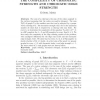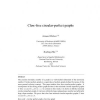751 search results - page 19 / 151 » The Distinguishing Chromatic Number |
CC
2006
Springer
13 years 8 months ago
2006
Springer
The sum of a coloring is the sum of the colors assigned to the vertices (assuming that the colors are positive integers). The sum (G) of graph G is the smallest sum that can be ach...
ALGORITHMICA
2004
13 years 8 months ago
2004
We consider the Chromatic Sum Problem on bipartite graphs which appears to be much harder than the classical Chromatic Number Problem. We prove that the Chromatic Sum Problem is NP...
JGT
2008
13 years 8 months ago
2008
A homomorphism from an oriented graph G to an oriented graph H is a mapping from the set of vertices of G to the set of vertices of H such that ----(u)(v) is an arc in H whenever...
WG
2004
Springer
14 years 1 months ago
2004
Springer
We show how to use split decomposition to compute the weighted clique number and the chromatic number of a graph and we apply these results to some classes of graphs. In particular...
ENDM
2007
13 years 8 months ago
2007
The circular chromatic number of a graph is a well-studied refinement of the chromatic number. Circular-perfect graphs is a superclass of perfect graphs defined by means of this...


